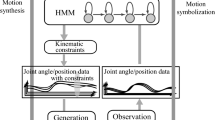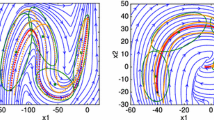Abstract
The goal of Learning from Demonstration is to automatically transfer the skill knowledge from human to robot. Current researches focus on the problem of modeling aperiodic/periodic robot motions and extracting dynamic task parameters from the recorded sensory information. However, it is still not adequate for describing complex behaviors in an unstructured environment, such as searching for an unknown fitting position or painting/polishing an irregular surface. The quasi-periodic and stochastic properties cause a high demand for generalization ability of the modeling techniques. This paper proposes a systematic framework for learning quasi-periodic robot motions, which contains three steps: decomposition, modeling, and synthesization. Firstly FFT transform is performed to identify all the frequencies in the quasi-periodic motion. Then the motion is decomposed into an offset component, a series of harmonic and corresponding envelop components based on the concept of equivalent transformation. The offset component is extracted by Empirical Mode Decomposition, harmonic is separated by notch filter, and envelope component is extracted by Hilbert Transform. These components are either periodic or aperiodic. The aperiodic motions can be modeled by conventional techniques such as Gaussian Mixture Model and recovered by Gaussian Mixture Regression. The periodic motions are modeled in closed-form expressions. Finally, they are synthesized together to regenerate the robot motion. This modeling process captures both the aperiodicity and periodicity of a quasi-periodic motion. Simulation and experiment show that the proposed methods are feasible, effective and can predict robot motions beyond demonstrations. With this generalization ability, it is able to reduce the programming difficulty and demonstration complexity.












Similar content being viewed by others
References
Argall, B. D., Chernova, S., Veloso, M., & Browning, B. (2009). A survey of robot learning from demonstration. Robotics & Autonomous Systems, 57(5), 469.
Asakawa, N., & Takeuchi, Y. (1997). In Proceedings of international conference on robotics and automation (vol. 3, pp. 1875–1879).
Billard, A., Epars, Y., Calinon, S., Schaal, S., & Cheng, G. (2004). Discovering optimal imitation strategies. Robotics and Autonomous Systems, 47(2), 69. Robot Learning from Demonstration.
Billard, A., & Hayes, G. M. (1999). Drama, a connectionist architecture for control and learning in autonomous robots. Adaptive Behavior, 7(1), 35.
Böckmann, A. (2017). T. Laue. In S. Behnke, R. Sheh, S. Sarıel, & D. D. Lee (Eds.), RoboCup 2016: robot world cup XX (pp. 33–44). Cham: Springer International Publishing.
Calinon, S. (2016). A tutorial on task-parameterized movement learning and retrieval. Intelligent Service Robotics, 9(1), 1.
Calinon, S., Guenter, F., & Billard, A. (2007). On learning, representing, and generalizing a task in a humanoid robot. Piscataway: IEEE Press.
Chen, H., Cheng, H., Liu, J., Zhang, B., Zhang, G., & Fuhlbrigge, T. (2013). In: 2013 IEEE international conference on automation science and engineering (CASE), (pp. 540–545). 10.1109/CoASE.2013.6653989
Chen, H., Wang, J., Zhang, G., & Fuhlbrigge, T., & Kock, S. (2008). In 2008 IEEE conference on robotics, automation and mechatronics (pp. 24–29).
Chen, H., & Xi, N. (2012). Automated robot tool trajectory connection for spray forming process. Journal of Manufacturing Science & Engineering, 134(2), 021017.
Chen, H., Xi, N., Sheng, W., & Chen, Y. (2005). General framework of optimal tool trajectory planning for free-form surfaces in surface manufacturing. Journal of Manufacturing Science & Engineering, 127(1), 49.
Daji, H., Jinping, Z., & Jilan, S. (2003). Practical implementation of the hilbert–huang transform algorithm. Acta Oceanologica Sinica, 25(1), 1–11.
Feldman, M. (2011). Hilbert transform applications in mechanical vibration. Hoboken: Wiley.
Graeve, K., Stueckler, J., & Behnke, S. (2011). Robotics, 1–8.
Gu, Y., Sheng, W., Crick, C., & Ou, Y. (2018). Automated assembly skill acquisition and implementation through human demonstration. Robotics and Autonomous Systems, 99, 1.
Huang, N. E., Shen, Z., Long, S. R., Wu, M. C., Shih, H. H., Zheng, Q., et al. (1998). The empirical mode decomposition and the hilbert spectrum for nonlinear and non-stationary time series analysis. Proceedings Mathematical Physical & Engineering Sciences, 454(1971), 903.
Ijspeert, A. (2003). Learning attractor landscapes for learning motor primitives. Neural Information Processing Systems, 15, 1523.
Kharidege, A., Du, T. T., & Zhang, Y. (2017). A practical approach for automated polishing system of freeform surface path generation based on industrial arm robot. International Journal of Advanced Manufacturing Technology, 1, 1.
Lee, S. H., Suh, I. H., Calinon, S., & Johansson, R. (2015). Autonomous framework for segmenting robot trajectories of manipulation task. Autonomous Robots, 38(2), 107.
Levitan, B. M., & Zhikov, V. V. (1982). Almost periodic functions and differential equations. Cambridge: Cambridge University Press.
Marvel, J. A., Newman, W. S., Gravel, D. P. Zhang, G., Wang, J., & Fuhlbrigge, T. (2009). In: IEEE international conference on robotics & biomimetics.
Meier, F., & Schaal, S. (2016). A probabilistic representation for dynamic movement primitives, CoRR arXiv:1612.05932
Meng, F. (2008). Trajectory and spray control planning on unknown 3d surfaces for industrial spray painting robot, Dissertations & Theses Gradworks.
Moghtaderi, A., Flandrin, P., & Borgnat, P. (2013). Trend filtering via empirical mode decompositions. Computational Statistics & Data Analysis, 58(1), 114.
Nagata, F., Watanabe, K., & Izumi, K. (2001). In: 2001 Proceedings on IEEE international conference on robotics and automation, (vol. 1, pp. 319–324).
Nehorai, A. (1985). A minimal parameter adaptive notch filter with constrained poles and zeros. IEEE Transactions on Acoustics, Speech, and Signal Processing, 33(4), 983.
Patterson, A. L. (1934). A fourier series method for the determination of the components of interatomic distances in crystals. Physical Review, 46, 372.
Potkonjak, V., Đorđević, G. S., Kostić, D., & Rašić, M. (2000). Dynamics of anthropomorphic painting robot Quality analysis and cost reduction. Robotics and Autonomous Systems, 32(1), 17.
Regalia, P. A. (1991). An improved lattice-based adaptive iir notch filter. IEEE Transactions on Signal Processing, 39(9), 2124.
Reiley, C. E., Plaku, E., & Hager, G. D. (2010). In: International conference of the ieee engineering in medicine and biology, (pp. 967–970).
Schaal, S. (2006). Dynamic movement primitives a framework for motor control in humans and humanoid robotics. Tokyo: Springer.
Schneider, M., & Ertel, W. (2010). Ieee/rsj international conference on intelligent robots and systems, (pp. 255–260).
Suh, S. H., Woo, I. K., & Noh, S. K. (1991). Automatic trajectory planning system (atps) for spray painting robots. Journal of Manufacturing Systems, 10(5), 396.
Tam, H. Y., Lui, C. H., & Mok, A. C. K. (1999). Robotic polishing of freeform surfaces using scanning paths. Journal of Materials Processing Technology, 95(1), 191.
Tow, A. W., Sünderhauf, N., Shirazi, S., Milford, M., & Leitner, J. (2017). What would you do? acting by learning to predict, CoRR arXiv:1703.02658
Vuković, N., Mitić, M., & Miljković, Z. (2015). Trajectory learning and reproduction for differential drive mobile robots based on gmm/hmm and dynamic time warping using learning from demonstration framework. Engineering Applications of Artificial Intelligence, 45, 388.
Webb, W. T. (1994). Modern quadrature amplitude modulation: Principles and applications for fixed and wireless channels. Piscataway: IEEE Press.
Wensing, P. M., & Slotine, J.-J. (2016). Sparse control for dynamic movement primitives, CoRR arXiv:1611.05066
Wu, Z., & Huang, N. E. (2004). A study of the characteristics of white noise using the empirical mode decomposition method. Proceedings of the Royal Society of London A: Mathematical, Physical and Engineering Sciences, 460(2046), 1597.
Wulfmeier, M., Rao, D., Wang, D. Z., Ondruska, P., & Posner, I. (2017). Large-scale cost function learning for path planning using deep inverse reinforcement learning. The International Journal of Robotics Research, 36(10), 1073.
Zeng, Y., Gong, J., & Ning, H. (2011). in International conference on electric information and control engineering (pp. 5570–5573).
Zhang, B., Gravel, D., Zhang, B., Wang, J., & Bell, A. (2011). In IEEE international conference on robotics and automation, ICRA 2011, Shanghai, China, 9–13 May (pp. 464–469).
Author information
Authors and Affiliations
Corresponding author
Additional information
Publisher's Note
Springer Nature remains neutral with regard to jurisdictional claims in published maps and institutional affiliations.
Rights and permissions
About this article
Cite this article
Li, X., Cheng, H., Chen, H. et al. Learning quasi-periodic robot motions from demonstration. Auton Robot 44, 251–266 (2020). https://doi.org/10.1007/s10514-019-09891-y
Received:
Accepted:
Published:
Issue Date:
DOI: https://doi.org/10.1007/s10514-019-09891-y




